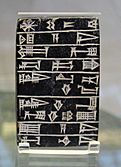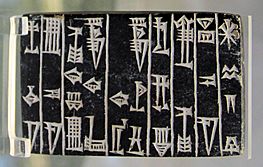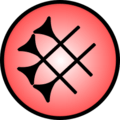Cuneiform (script) facts for kids
Cuneiform (say "kyoo-NEE-ih-form") is a very old way of writing. It was used in the ancient Middle East for thousands of years. People wrote with wedge-shaped marks, which is where its name comes from (cuneus means "wedge" in Latin).
Cuneiform was first created to write the Sumerian language in Mesopotamia (which is modern-day Iraq). It is the oldest known writing system in the world!
Over time, many other languages used cuneiform too. For example, the Akkadian people used it a lot. Later, the Hittite language also adapted cuneiform. Other languages like Eblaite, Elamite, Hurrian, Luwian, and Urartian also used this script. The last known cuneiform tablet was written in 75 AD.
People in modern times rediscovered cuneiform in the 1600s. Scientists finally figured out how to read it in the early 1800s. Today, experts who study cuneiform are called Assyriologists. There are about half a million cuneiform tablets in museums around the world. The British Museum has the largest collection, with about 130,000 tablets! Other big collections are in Berlin, Paris, Istanbul, Baghdad, Yale, and the Penn Museum.
How Cuneiform Was Used
(around 2094–2047 BC)
NIN-a-ni..................... "his Lady",
SHUL-GI.................... "Shulgi"
NITAH KALAG ga...... "the mighty man"
LUGAL URIM KI ma... "King of Ur"
LUGAL ki en............... "King of Sumer"
gi ki URI ke................. "and Akkad",
E a ni.......................... "her Temple"
mu na DU................... "he built"
People in ancient Mesopotamia used cuneiform for many things. They wrote on clay tablets, stone, and even wax boards. One wax board from the 8th century BC was found in Nimrud.
Cuneiform was used to write down laws, like the famous Code of Hammurabi. It was also used for maps, medical books, and religious stories. Some experts think it was used to record land surveys.
Not just kings and priests could read and write cuneiform. Many ordinary people also knew enough to write letters or business papers. More educated people used it for complex things like listing medicines or solving math problems. Scholars were the most skilled. They saw writing as a difficult skill and even an art form.
Cuneiform Today
Sometimes, cuneiform signs inspire modern logos.
-
The middle part of the GigaMesh Software Framework logo is the sign 𒆜 (kaskal). It means "street" or "road junction." This shows how different subjects like history and computer science can meet. The name GigaMesh also reminds us of the ancient story of Gilgamesh.
Major Cuneiform Tablet Discoveries
Many cuneiform tablets have been found at different ancient sites. These discoveries help us learn about the past. Here are some of the most important places where tablets were found:
| Location | Number of tablets | Year of First Discovery | Main Language |
|---|---|---|---|
| Khorsabad | Many | 1843 | |
| Nineveh | 20,000–24,000 | 1840–1849 | Akkadian |
| Nippur | 60,000 | 1851 | |
| Girsu | 40,000–50,000 | 1877 | |
| Dūr-Katlimmu | 500 | 1879 | |
| Sippar | Tens of thousands | 1880 | Babylonian |
| Amarna | 382 | 1887 | Canaano-Akkadian |
| Nuzi | 10,000–20,000 | 1896 | |
| Assur | 16,000 | 1898 | Akkadian |
| Hattusa | 30,000 | 1906 | Hittite |
| Drehem | 100,000 | Sumerian | |
| Kanesh | 23,000 | 1925 | Akkadian |
| Ugarit | 1,500 | 1929 | Ugaritic |
| Persepolis | 15,000–18,000 | 1933 | Elamite, Old Persian |
| Mari | 20,000–25,000 | 1933 | Akkadian |
| Alalakh | 300 | 1937 | |
| Abu Salabikh | 500 | 1963 | |
| Ebla | about 5,000 | 1974 | Sumerian and Eblaite |
| Nimrud | 244 | 1952 | Neo-Assyrian and Neo-Bablyonian |
See also
 In Spanish: Escritura cuneiforme para niños
In Spanish: Escritura cuneiforme para niños




